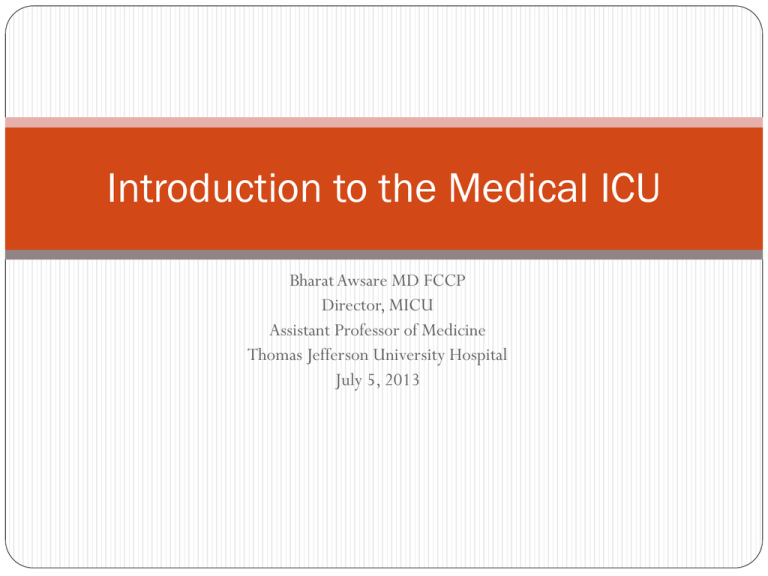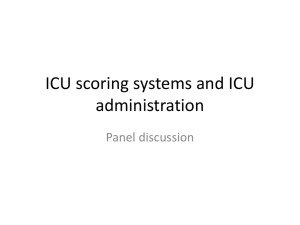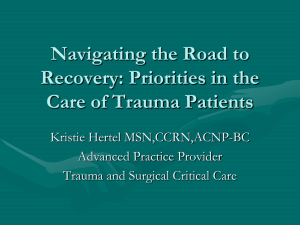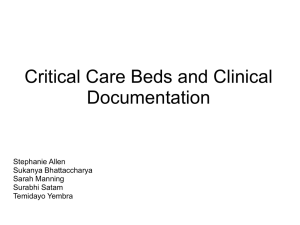Introduction to the Medical ICU
advertisement

Introduction to the Medical ICU Bharat Awsare MD FCCP Director, MICU Assistant Professor of Medicine Thomas Jefferson University Hospital July 5, 2013 Overview History of ICU medicine Types of ICU Triage criteria Role of fellow in the ICU Protocols of note Initiatives of note Florence Nightingale Born 1820 in Florence Italy Crimean War in Turkey 1854 Only 1/6 of soldiers who died did so of wounds Rest died of typhus, cholera, dysentery Recognized improved outcomes when patients with similar diseases and severity could be grouped in specific areas of hospital Phillip Drinker Harvard (1927): Iron lung developed and presented in article titled “The use of a new apparatus for the prolonged administration of artificial respiration: A fatal case of poliomyelitis” Donation to Bellevue Hospital where it saved a woman dying from overdose of an unknown compound W.E. Dandy 1928: established a 3 bed post- neurosurgical ICU in Baltimore at Johns Hopkins World War II Shock wards established for resuscitation Transfusion practices in early stages After WWII, nursing shortage forced grouping of postoperative patients in recovery areas History of ACLS 1947—Claude Becker invents first defibrillator 1947—1st life saved with debrillator Polio epidemic 1950’s: use of mechanical ventilation (“iron lung”) for treatment of polio Development of respiratory intensive care units At the same time, general ICU’s developed for sick and postoperative patients Peter Safar First intensivist doctor Received anesthesia training at Penn Started “Urgency and Emergency Room”—now known as ICU in 1958 (Baltimore) Artificial ventilation, cardiac massage became popular Father of cardiac resuscitation 1962—Pittsburgh establishes first critical care fellowship 1957 Increase in ICU beds 1958: ¼ of community hospitals with 300 beds had an ICU Late 1960’s: most US hospitals had ICU’s 1970: SCCM established by 29 physicians in Los Angeles 1986: critical care certification through anesthesiology, surgery, internal medicine, pediatrics Types of ICU’s Open ICU model—patient admitted under care of an internist, family practitioner, surgeon, or specialist with an elective critical care consultation Intensivist co-management—open ICU with mandatory critical care consultation Closed ICU—patients transferred to care of intensivist after evaluation/approval Mixed ICU model—overlap of above OUR MEDICAL ICU IS A CLOSED ICU MODEL Jefferson MICU 5th floor Gibbon 17 full ICU beds 5 interns, 3 residents provide 24/7 coverage 24/7 fellow coverage Attending intensivist available 10-12 hrs/day in house and the rest on call for backup 3rd floor Gibbon 8 full ICU beds Nurse practitioners provide 24/7 coverage 24/7 fellow coverage Attending intensivist available 10-12 hrs/day in house and the rest on call for backup MICU no longer has an intermediate ICU such as ISICU, INICU Intensivist job description Patient care Multidisciplinary rounds Bed allocation/triage Quality control (infection control, safety, evidence based practive) Protocol development Education Residents, fellows, med students, nurses, respiratory therapists, nurse practitioners Research Quality assurance projects Clinical trials Database-driven projects Admission/discharge criteria Meant to be used as a guideline to triage patients Remember: ICU beds are a finite resource—it is the job of the intensivist to best utilize this finite resource Diagnosis model for triage Objective parameters model Diagnosis model for triage Objective parameters model Admissions to MICU ER (Average approx. 30/month) Wards (Average approx. 35/month) Transfers (Average approx. 25 month) Less common Jefferson ICUs Direct admissions Right heart catherization Desensitization General guidelines All patient movement requires notification of the patient flow management center (PFMC): transfer center plus central scheduling (5-1515) Intensivist or designee (fellow) should be notified for all admissions Jefferson has mandated a “Don’t say no” policy for outside transfers General guidelines for bed management Role of the ICU attending/fellow should be facilitator Get the patient to the ICU as soon as reasonably feasible Patient care improved in ICU setting as compared to ER or general wards Physician at the bedside should have the advantage in deciding triage All conflicts should go up chain of command quickly ie FellowICU attendingICU directorCritical Care Co- directorChief Medical Officer Conflicts should be handled attending to attending ultimately All patients not accepted to ICU should be discussed with the ICU attending Methods to admit Through ER ER may directly admit to ICU without another evaluation by the MAR or ICU resident (Hospital by-law) ER physician will call fellow or attending Unit charge nurse notified for bed allocation Goals: Initiate therapy in ED Therapy may be modified after consultation of ICU team Transfer patient to ICU ASAP without having ICU housestaff including fellow leave ICU ER “4 hour rule” JHACO requirement Patients triaged to admission must be transported out of the ER within 4 hours TJUH has allocated 90 minutes for “acceptance” THUH has allocated 150 minutes for signout and transport Methods to admit From floors Primary team resident evaluates patient on floors, discuss with ICU team for admission Not necessary to have housestaff leave ICU Handoff should include chart documentation of plan of care and physician to physician communication Methods to admit From outside institutions Attending:attending exchange of information Fellow may be asked to assist Notify patient flow management center (5-1515) Notify charge nurse Obtain more detailed patient related information For transfers from outside institutions, it is the outside institution’s responsibility to ensure safe transfer (ie stable airway, relatively stable hemodynamics, etc) Post-code Patient triaged at bedside by Code Blue team leader ICU fellow and/or attending notified of transfer Primary team attending notified of change of status Family notified of change of status Post-RRT About half of RRT’s come to ICU About 1/3 are intubated (automatic transfer) Senior physician at bedside currently triages patient (fellow or resident) If resident feels patient should come to ICU Notify primary attending (if patient doesn’t emergently need to come to ICU) If attending agrees, patient comes to ICU notify fellow If resident feels patient does not need ICU Notify primary attending if that attending disagrees, resident is overruled and patient is transferred to ICU fellow notified Non-RRT/code transfers No more “head’s up” calls to fellows Fellows/unit residents do not do ICU evaluations (done by primary team) Floor residents should go up chain of command prior to calling ICU i.e. intern resident GI fellow GI attending After going up chain of command, options are: 1. Manage patient on wards with primary attending/fellow supervision 2. Call fellow after evaluating patient and discuss why patient should come to ICU and patient is triaged by fellow/ICU attending If primary attending disagrees, should call ICU attending 3. Pulmonary/critical care consultation when there is uncertainty General principles Keep primary attending informed Keep families informed Keep Patient Flow Management Center (PFMC) informed If there is disagreement between where a patient should go, go up the chain of command (ultimately attending-attending discussion is always encouraged) Typical ICU day for fellow 7:00-7:30 Overnight signout 7:30-8:30 Conferences 8:30-9 am ABCDE rounds with charge nurse, RT, PT, nurse 9am-12pm Multidisciplinary rounds 12-1pm Lunch/conference (ICU lecture series) 1pm-4pm Patient care (lines, interact with consultants, follow-up issues) 4pm-5 pm Afternoon rounds 7 pm Signout to overnight fellow 7 pm-? Nocturnal rounds with housestaff, nursing ICU expectations (from fellow handbook) Knowledge of all patients on service Implementation of daily care plan Coordination of care Admission/triage of new patients All new patients need note from fellow or attending Knowledge of protocols/initiatives/research studies Supervision of housestaff/NP’s Ventilatory management Team liaison for case management Help populate ICU database (Dr. Oxman to speak further) Professionalism Over three years, work toward independent decision making Additional fellow responsibilities 4th Tuesday each month MICU working group Discussion of infection rates, QA issues, ICU projects 1st Wednesday each month Special Care Unit Subcommittee Hospital wide patient care and safety issues Tuesday, Thursday at 1 pm—Case management rounds Triage points Triage decisions will never be 100% accurate Better to be wrong about a soft admission who leaves ICU within 24 hours rather than the borderline patient who is transferred from wards to ICU within 48 hours Propensity scores can sometimes help, but they will never replace clinical judgment of physician at the bedside Pneumonia Severity Index Rockall Score (GI bleed) APACHE score Severe sepsis criteria Important initiatives Sepsis pathway GI bleed pathway Ventilator management ARDS protocol Ventilator bundle (“VAP bundle”) DVT prophylaxis GI prophylaxis HOB elevation Oral care Sedation management NOTE: most MICU patients have subglottic suctioning ETT’s ABCDE Severe sepsis initiative Severe sepsis identified using electronic chart alerts Protocol driven initial management in ER, continued in ICU Goal is to quickly transfer patients to ICU “Automatic” acceptance of patients diagnosed as severe sepsis ER to notify fellow who notifies PGY 2 (**Physician information order**) ER will notify patient flow management center who will notify charge nurse TRANSFER SHOULD NOT COMPROMISE PATIENT CARE Antibiotics IV access, fluids, pressors Central line if pressors needed Inclusion Criteria Suspected Infection AND at least 2 of SIRS Criteria SIRS Criterion: Fever (core temperature > 38.3 C or 101.0 F) or hypothermia (core temperature < 36 C or 96.8 F) SIRS Criterion: Heart rate > 90 beats/min SIRS Criterion: Respiratory rate > 20 breaths min or PaCO2 < 32 or need for mechanical ventilation for an acute respiratory process SIRS Criterion: WBC > 12,000/mm3, < 4,000/mm3, or bands > 10% Organ dysfunction - one of the following must be new and thought to be due to infection: Hypotension (SBP<90mmHg or MAP < 65mmHg despite initial fluid bolus) Lactate > 4mmol/L UOP < 0.5 mL/kg/hr despite initial fluid bolus or creatinine increase > 0.5 mg/dL above baseline PaO2/FiO2 ratio < 300 or requiring > 4L NC O2 to maintain O2 sat>90% Platelets < 100,000mm3 or INR>1.5 or PTT>60 sec Processes of care being monitored Blood Culture before antibiotics Antibiotics within 3 hours Adequate initial fluid bolus (now 30 cc/kg) Pressors if MAP<65 or systolic BP<90 Outcomes Our Progress to Date TJUH, Inc. Sepsis Mortality Ratio Sepsis TJUH: Premier vs UHC MSDRG 870872 Our Progress to Date Sepsis Mortality: UHC 2012 Risk model TJUH, Inc. 35.00% 30.00% 25.00% 20.00% Observed Expected 15.00% 10.00% 5.00% 0.00% Q1 Q2 Q3 Q4 Q1 Q2 Q3 Q4 Q1 Q2 Q3 Q4 20102010201020122011 2011 2011 2011 2012201220122012 GI bleed pathway Same paradigm Early risk stratification and triage (using Rockall score) Early protocol driven management Evidence based guideline to therapeutic management Coordination of care between multiple specialties Education Implementation Monitoring Tweaking Changing Paradigm of ICU Care What are the components of the ABCDE Bundle? Awakening and Breathing Coordination Choice of Analgesics and Sedatives Delirium Identification and Management Early Exercise and Mobility Choice of Analgesics and Sedatives The Points choiceon driven by: Key Sedation Goals•forBolus eachfirst patient and then Clinical pharmacology consider continuous Costs infusion. • Assess and target. • Daily interruption Patient Factors Increased age Alcohol use Male gender Living alone Smoking Renal disease Delirium: What Can We Do? Less Modifiable DELIRIUM Environment Admission via ED or through transfer Isolation No clock No daylight No visitors Noise Use of physical restraints More Modifiable Predisposing Disease Cardiac disease Cognitive impairment (eg, dementia) Pulmonary disease Acute Illness Length of stay Fever Medicine service Lack of nutrition Hypotension Sepsis Metabolic disorders Tubes/catheters Medications: - Anticholinergics - Corticosteroids - Benzodiazepines Diagnosis is Key !! Confusion Assessment Method for the ICU (CAM-ICU) Feature 1: Acute change or fluctuating course of mental status And Feature 2: Inattention And Feature 3: Altered level of consciousness Or Inouye, et. al. Ann Intern Med 1990; 113:941-948.1 Ely, et. al. CCM 2001; 29:1370-1379.4 Ely, et. al. JAMA 2001; 286:2703-2710.5 Feature 4: Disorganized thinking Treatment of delirium in the ICU Non-pharmacologic Treatment of inciting condition Re-orientation Familiar objects from home Cognitive stimulation Television news Non-verbal news Minimize unwanted noise Sleep hygiene Early mobilization Range of motion Remove restraints, catheters, lines Eye glasses, hearing aids Pharmacologic Review analgesics, sedatives Haloperidol Risperidol, quetiapine, etc. Immobility not beneficial and associated with harm Myopathy and/or neuropathy Delayed weaning from ventilator Delirium Infections Pressure ulcers Early Progressive Exercise and Mobility Early progressive mobility programs result in: Better patient outcomes Shorter hospital stays Decreased development of hospital acquired complications The level of exercise and mobility is individualized and incrementally progressed Early Progressive Exercise and Mobility Algorithm It Takes a Team! Respiratory PT/OT Nursing Patient Pharmacists Physicians









